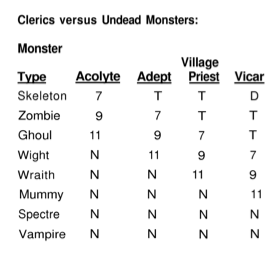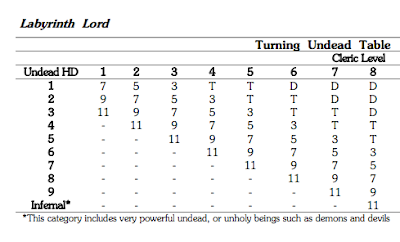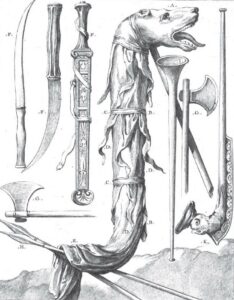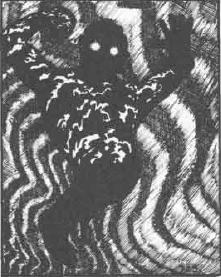
Image from LotFP store
Let’s talk about agency and horror. A big part of horror is not being in control, and perhaps being in situations that don’t make sense. Horror movies use all kinds of techniques in an attempt to achieve this effect, from dissonance in music to odd camera angles. The general trajectory of a horror story usually goes from mundane reality to twisted reality, and then back to mundane reality after the denouement, though sometimes in a way that things can never be the same again (the is a common trope of Lovecraft, due to possession of some forbidden cosmic knowledge).
Agency is, in some ways, the exact opposite of this, and undermines horror to the extent that you have it. True agency implies that the world around you is understandable, is amenable to problem solving, and that ultimately the choices that you make matter. Agency is also what much old school gaming philosophy is based around. It’s the why nonlinear dungeons are prized, and why the sandbox is held up as the setting ideal. On the one hand, roleplaying as a medium is uniquely suited to horror, because the player identifies with the PC in a direct way that is almost impossible to achieve in other forms. On the other hand, choices that matter undermine the sense of helplessness that is intrinsic to horror.
The Monolith from Beyond Space and Time is thus in a tricky place, trying to straddle the somewhat incongruent genres of cosmic horror and gaming that preserves agency. At its best, Monolith presents some truly wonderful vignettes, set pieces, and innovative mechanics that can be used with any traditional fantasy roleplaying game. It also contains some absurdities, however, ostensibly in an effort to evoke the sense of paradox and impossibility of Lovecraftian horror. A few brief notes about the presentation of the module before I continue to talk about the content. The illustrations by Aeron Alfrey are wonderful and unique, and fit the mood perfectly (the lightsurfing invaders image is a particular favorite of mine). The layout is also clear and lacks distracting background images that compete with the text (a problem that has marred some past Lamentations releases). This is the best looking Lamentations module to date, in my opinion.
It’s impossible to talk about this module intelligently without giving anything away, so consider this a spoiler warning. You can jump down to the paragraph that begins “This module is a welcome reminder” if you want to totally avoid spoilers. Despite the hedged praise I have above, there are number of encounters and aspects of Monolith that just don’t seem like they would work very well in a roleplaying context, mostly because of predetermined endings.
Consider, for example, the Owls’ Service encounter (this is beautifully written, by the way, and works much better as a short story than it does as an encounter). In it, the players encounter a clearing with some large owl statues and a skeleton which are surrounded by tangled vegetation. There is no way out, and just to make that clear, here is the advice that the referee is given (page 14):
Slicing through the plants slowly drains HP through sheer exhaustion: 1 point per hour, or whatever is necessary to deliver the message. Parties or players desperately interested in prolonged, miserable combat with an unkillable foe too wet to burn and too deeply rooted to extract should be rewarded: suitably crawly wandering creatures, down where the plants hide them, begin striking for heroes’ Achilles tendons. Meanwhile, sap takes the polish off metal or lacquer surfaces as vines entangle straps and buckles holding armor on. The kindly Referee can provide a fighter’s corpse, pinned by thousands of plant roots and vines, the body slowly becoming the thing that killed it. If players seem particularly slow to get the point, the fighter wears ruined armor just like one player’s, down to the same maker and year stamped on a rivet or vambrace: armor now a useless, scummed-over basin for more plants. Moving back toward the clearing is considerably easier: the plant barrier effect seems directional.
The real meat of the encounter is similarly meaningless in terms of gaming content. There is no way to learn about it, defeat it through skillful play, or even avoid it. It is merely a way to inflict a tragic fate upon a PC. As Raggi writes:
Solutions? Explanations? The Monolith owes you none.
The Owls’ Service is a great story, but a terrible encounter. Inescapable tragedy is horrific (it is the source of the horror in the Oedipus cycle, for example), but I’m not sure it has any place in a roleplaying game, at least when applied to PCs. There may be exceptions for games with a very limited objective. Paranoia, perhaps? Or Call of Cthulhu? I don’t really have experience with either. In any case, I think that Monolith is marketed to games interested in weird fantasy, not inescapable fate. Also, many of the consequences of this module only flower in the context of a campaign that continues; it doesn’t really deliver its payload as a one-shot (the same thing is true of Death Love Doom, the other recent Raggi module, which I will probably cover in a future post).
The plateau encounter is another example of a “screw you” encounter that is impossible to avoid. The characters suddenly find themselves on a plateau and “turning around and going back is not an option” (page 15). Any attempt to descend the cliff safely results in damage as if they fell the entire distance, but jumping off the cliff is completely safe, and there’s not really any way to determine this from the player’s perspective. Further (same page):
If a character jumps off the edge in despair with the serious intent of committing suicide (Referee judgment), the character of course does not die, and they get to reroll all of their ability scores, keeping any results that are greater than the original values.
I consider this encounter to be a total failure from the design perspective, though it has potential to be interesting with a bit more infrastructure, especially if the hazard is also a shortcut of some kind. That would provide an interesting choice.
Here are a lot of things things that I liked, too. The mist encounter. Why should geography always work as expected in a fantasy world? Does anyone remember the enchanted forests from some of the Zelda games? This effect is similar, though I also believe it could use some clues. The community of hedonists is well crafted, if you like moral dilemmas (and this one is much more interesting than the standard “monster babies” dilemma). The great weapon whose wielder is also its sheath.
There is a fascinating bit of agency inversion at work in this module, though it does not live up to its promise. PCs have almost no agency at all while in the valley (most of the valley encounters force the players to engage with them, and don’t allow players to affect the outcome in meaningful ways). However, once they get inside the monolith, there is no physical layout at all. Expressing a desire for something causes it to manifest. If you desire the exit, it appears before you. If you desire something to fight, that triggers an encounter with monolith denizens. There are many other examples of locations keyed to player desire rather than game world spacial relationship (and it is worth noting that the module has no maps). There is something really interesting about going from no agency to absolute agency, which might actually work if the lead-in encounters weren’t quite so crude in their drive to force players to experience the referee’s cool thing no matter what they do.
Despite these seemingly harsh criticisms, this module is a welcome reminder that these games are what we make them; there are no limits. Why not make dungeons where certain aspects can be mentally adjusted by the PCs? Why not mess with time? Who cares if the economy of the starting village is upended by loot from the dungeon? The consequences of these things are the stuff that memorable games are made of. As referees, we are often too cautious, not wanting to rock the boat for fear of “unbalancing” a campaign. To quote Heath Ledger’s Joker again:
Introduce a little anarchy. Upset the established order, and everything becomes chaos. I’m an agent of chaos. Oh and you know the thing about chaos, Harvey? It’s fair.
That is, in the end, the rub, and the reason that I can’t wholeheartedly recommend Monolith. There are parts of it that are not fair. There are no clues to many of the tricks within, which would be required for an agency-preserving game. Exactly what fair means in the context of a tabletop RPG deserves a more thorough treatment that is beyond the scope of this post, but I would be curious if anyone else who is familiar with the contents of this module would argue that it is fair.










